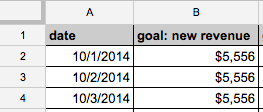Research on goal-setting has shown that, 90% of the time, setting specific and challenging goals results in higher performance. There are three reasons why goals are so effective:
- Psychological motivation. When you set a goal, you actually incorporate the outcome into your self-identity, setting in motion biochemical motivation to keep moving towards it. In other words, setting a goal is a powerful way to “hack your brain.”
- Focus. There are hundreds of things that you could be doing to improve your business right now, and new tactics to try are popping up every day. Having a goal makes it much easier to focus on the tactics that will help you hit your goal and avoid getting distracted by the latest shiny object.
- Learning. A goal is essentially a hypothesis. You set it because you think by achieving it a certain outcome will happen. Using goals in this way allows companies to quickly learn what is (and isn’t) driving growth for their company.
In this post, we’re going to teach you how to set up a goal-versus-actual spreadsheet that will help you tap into each of the three reasons goals are so effective: psychological motivation, focus, and learning.
How tracking your goals on a daily basis ‘hacks’ your brain http://ow.ly/IOfqS 
Step 1: Form a hypothesis
A goal is essentially a hypothesis. For example, let’s say your goal is to generate $500,000 in new revenue by the end of the quarter. Whether or not you’re explicitly stating it, there’s a hypothesis behind that goal, perhaps it’s something like this:
“If we launch a new referral program, we’ll be able to generate 5,435 new customers because 15% of customers will refer their friends. This will result in $500,000 in new revenue by the end of the quarter.”
If you hit that goal, amazing! You know that your referral program is a significant driver of new business and you’ve got some incredible social advocates. But if you don’t hit your goal, you have a starting place to learn: Did you overestimate how many customers would refer a friend? Was your average order value lower than expected for referred customers?
How to start thinking of goals as hypotheses http://ow.ly/IOfqS 
Setting up a goal and trying like hell to hit it forces you to learn. And sometimes, the information you learn will be more important than the actual result.
Step 2: Select your KPI
In this scenario, your KPI for success seems clear: if you reach $500,000 in new revenue, your program will be a success.
However, while having your success metric clearly defined, don’t make the mistake of focusing only on this narrow definition of success or failure. Keep your eyes open for learning opportunities along the way. Even if you fail to reach this goal, you might end up discovering valuable things – for example, maybe you’ll find that referred customers have a higher lifetime value after three purchases, or that only 5% of your customers made referrals, but they referred at an incredibly high rate.
Discoveries like these are golden, and explain why growth hackers are such big fans of goal-setting.
Step 3: Select your goal
Define your level of granularity
It is really important that you are setting goals at the appropriate level. For example, a goal around “revenue” might be perfect for a CEO, but too vague for people on the marketing team making on-the-ground daily tactical decisions. For them, it’s more useful to break the revenue goal down into “new revenue” or “revenue by source.” For the purposes of this step-by-step example, we’re focusing on the specific goal of generating new revenue.
Set your daily goals
Quarterly or monthly goals are great for executives. But the people making the call every day about what promotion to run or how to optimize a web page will need more visibility. For this reason, we recommend setting monthly goals but dividing them into daily increments you can measure progress against.
How to set up a simple spreadsheet to track your goals http://ow.ly/IOfqS 
To set this up, you’ll want to start with the end in mind. Since your goal is to have $2,066,832 in new revenue by the end of the quarter, you’ll need $172,236 in new revenue per month, which breaks down to $5,556 per day. You can try to create estimates based on day of the week or around special events, but that’s likely more sophistication than you need.
Establish your daily benchmarks
The next step is to set up a “cumulative new revenue” column. This is your daily benchmark to check if you’re on track to hit your monthly and quarterly goals. Use this formula to calculate your daily lead benchmark: =C2+B3
Step 4: Track your progress
With your goals set, it’s time to share with your team and start collecting some data. Open your spreadsheet each day and drop in the numbers from the day prior. Use this formula to see how your “actual: cumulative new revenue” compares to your “goal: cumulative new revenue”: =E2+D3
Step 5: Socialize
Once your goal is set, make sure to build in regular check-ins and share progress with your team. According to growthhackers.com research, 35% of marketers don’t share growth wins with their teams. Don’t miss opportunities like these – not only do they create motivation, but they help define a culture of success.
Since this is about learning, there’s no need to wait until the end of the quarter to evaluate your progress. If after a month, for example, it turns out you’re falling way short of your goal, you can look into what’s going on by asking some basic questions:
- Are we falling short because we overestimated referees’ willingness to purchase?
- Are we falling short because we’re giving the wrong referral incentive?
- Are we falling short because we’re asking for the referral the wrong way?
Making time to discuss progress towards your goal will both accelerate your learning and keep your team engaged and invested.
Step 6: Iterate
Once you’ve seen the positive results from tracking a high-level goal or two, the next step is to start branching out into more detailed goals, around things like:
- Website traffic
- New leads
- Items sold
Tracking a greater number of goals will require analyst time to pull the numbers on a daily basis. As you’ve probably seen from your own personal goal-setting endeavors, if it’s hard work just to track progress against a goal, it becomes very likely you’ll sweep the whole thing under the rug and forget about it.
When you’re ready to start tracking more detailed goals, it’s time to think about investing in the right tools. In the below video, we’ll show you how RJMetrics makes it easy to create automatically-updating goal vs. actual charts.




